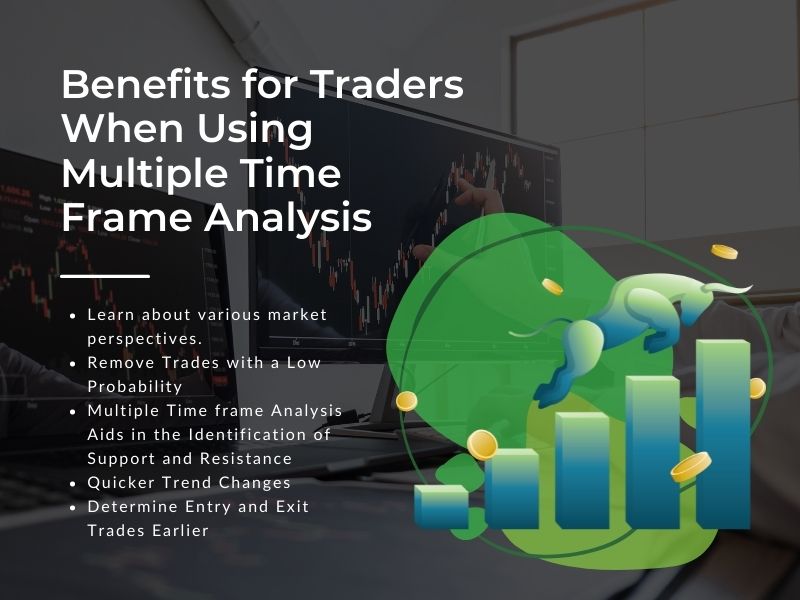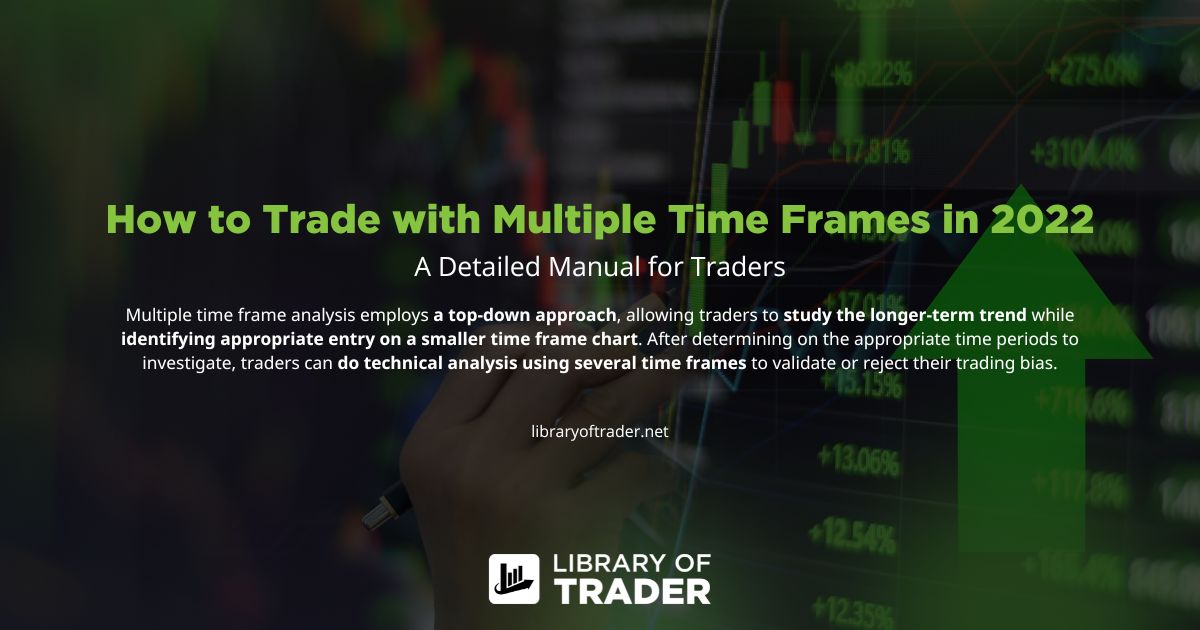Introduction
When trading, multiple time frames analysis takes a top-down strategy, allowing traders to analyze the longer-term trend while recognizing suitable entries on a smaller time frame chart. Traders can undertake technical analysis utilizing several time frames to validate or reject their trading bias after deciding on the proper time periods to study.
Continuing reading this blog will teach you what is multi-time frame analysis, which forex time frames can be applied to it, and how to optimize it.
What Is Multiple Time Frame Analysis?

Multiple time-frame analysis entails tracking the same currency pair at various frequencies (or time compressions). While there is no true limit to how many frequencies may be monitored or which exact ones to choose, most practitioners will adhere to broad principles.
When transitioning between time frames, a ratio of 1:4 or 1:6 is recommended. The reasoning behind this strategy is to be able to detect tiny, nuanced price swings for well-timed market entrances. However, focusing on extremely tiny time periods is pointless because most price fluctuation has little influence on the entire transaction and can produce undue worry when the market appears to be moving swiftly.
When observing the trend on an hourly chart, for example, traders can zoom into the 10-minute chart (1:6) or the 15-minute chart (1:4) for appropriate entry. The 10 or 15-minute chart indicates short-term events, while the hourly chart is where the trade’s progress may be tracked in the future.
How Many Types of Multiple Time Frame Analysis?

Long-Term Time Frame
Now that you’ve laid the framework for describing various time frame analysis, it’s time to apply it to the forex market. When viewing charts using this strategy, it is often better to begin with the long-term time frame and work down to the more granular frequencies. The prevailing trend may be identified by looking at the long-term time period.
Fundamentals have a substantial effect on currency market direction when the long-term time frame includes a daily, weekly, or monthly periodicity. As a result, when following the overall trend in this time frame, a trader should keep an eye on the important economic movements. Whether the major economic issue is current account deficits, consumer spending, company investment, or any of a variety of other factors, these changes should be closely tracked in order to better understand the direction of price action. At the same time, such dynamics change seldom, much as the price trend in this time period, thus they just need to be reviewed on occasion.
Medium-Term Time Frame
When the granularity of the same chart is increased to the intermediate time frame, tiny movements within the larger trend become obvious. This is the most adaptable of the three frequencies since it may provide information on both short-term and long-term time periods. As previously stated, the projected holding period for a typical deal should serve as the anchor for the time frame range. In fact, while designing a trade and as the position approaches its profit objective or stop loss, this level should be the most often observed chart.
Short-Term Time Frame
Finally, trades should be done on a short-term basis. As the tiny price variations become more visible, a trader is better equipped to select an appealing entry for a position whose direction has already been determined by the higher frequency charts.
Another factor to consider for this time frame is that fundamentals have a strong effect on price behavior in these charts, but in a totally different way than they do in higher time frames. When charts are less than four hours in length, fundamental patterns are no longer evident. Instead, the short-term time period will react to market moving signs with heightened volatility. The more granular this smaller time range, the greater the apparent responsiveness to economic data. These abrupt movements are frequently labeled as noise since they endure for such a short period of time.
Benefits for Traders When Using Multiple Time Frame Analysis

Learn about various market perspectives
You might detect different trends while studying price history from different chart time periods. Some of these developments will be diametrically opposed. The market’s range of viewpoints gives additional input and data to make a trading decision.
Remove Trades with a Low Probability
Using different time frames in your chart analysis is a simple three-step procedure. First, determine the trend’s direction on the longer-term chart. Second, search for signs that correlate with the longer-term trend on the smaller time frame chart. Finally, place the trade that corresponds to the longer-term trend. This technique eliminates short-term counter-trend signals with a low likelihood.
Multiple Time frame Analysis Aids in the Identification of Support and Resistance
When analyzing a price chart, we sometimes fail to zoom out far enough to see longer-term important levels that may affect our transaction. A 5-year trend line, for example, might be apparent on a daily or weekly chart but not necessarily on a 2-hour chart. As a result, longer-term chart trend analysis can assist you in identifying these crucial levels and avoiding getting caught on the wrong side of a trade.
Quicker Trend Changes
When your attention is drawn to the longer term, the shorter-term pattern may begin to shift before you notice it. Assume you prefer to examine and trade utilizing the daily price chart. If the 1-hour chart, for example, indicated a trend change, you might utilize that information to alter your trade appropriately.
Determine Entry and Exit Trades Earlier
As the preceding benefit implies, using a smaller chart time period allows you to detect trend shifts early. This allows you to enter trades before the signal emerges on the higher time frame chart. The same concept applies when quitting a deal.
How Multiple Time Frame Analysis Works
Multiple time frames analysis is a straightforward three-step procedure.
- Determine the trend’s direction on a longer-term chart.
- Short-term chart indications should be filtered in the direction of the longer-term trend.
- Make the deal
How to Choose the Best Forex Time Frame
Many traders, both novice and experienced, are curious about how to choose the optimal time period to trade forex. In general, traders should choose a time window based on:
- the amount of trading time available every day
- the most widely used time window for identifying trade setups
How to Identify the Best Time Frame for Different Trading Style
For Swing Traders
A swing trader is someone who enters deals and holds them for several days. Their purpose is to spot trends and then purchase or sell an asset for a period of time. Swing traders typically employ hourly, four-hour, or even daily charts. In most circumstances, utilizing a weekly chart is pointless.
For Day Trader and Scalper
A day trader is someone who starts and closes deals inside a single trading day. Day traders are classified into two groups.
First, there are scalpers, who begin a deal and then quickly close it after making a modest profit. These traders employ charts with time frames less than 10 minutes. As a result, their multi-timeframe research might include looking at 15-minute, 10-minute, 5-minute, and 1-minute charts.
Second, some day traders aim to hold a deal for several minutes. Their main objective is to get all deals closed by the time they retire to bed. In this scenario, a multi-timeframe study may include looking at a daily chart, four-hour chart, and hourly chart.
For Long-term traders
Long-term traders, on the other hand, focus on purchasing or shorting an asset and then holding the deal for days or months. This study may look at monthly, weekly, daily, and hourly charts for these. To select which charts to employ, you must first understand who you are as a trader and then use the appropriate chart.
Multiple Time Frames Analysis: What to Avoid
Multi-time frame analysis is a useful and adaptable technique. However, it is not a one-size-fits-all solution, and it has significant restrictions. I’ve seen two typical errors with this type of study.
To begin, traders employ time frames that are too close together. They will, for example, use a 4-hour chart for the trend and a 2-hour chart for the signal. There isn’t enough space between the time frames, thus you miss out on the benefit of evaluating many time frames.
Second, traders employ time frames that are far apart. This is a common error made by scalpers and day traders. They’ll look at the daily chart for trends but utilize the 5-minute chart for signals. The trend on the daily chart has minimal bearing on your 5-minute chart trade.
Multiple time frames analysis works best when traders stick to the 4:1 or 6:1 ratio mentioned above for daily charts.
Multiple Time Frames Analysis: Tips & Tricks
- When performing various time frame analysis, always generate long and short trading scenarios. This keeps you open-minded and prevents you from thinking in one dimension. A trader searching just for short trades will ignore any signs indicating a long trade. Alternatively, a trader on a long trade may overlook indications that indicate a reversal.
- Separate your charting from your trading platform as well. If you can see your open orders on your displays while analyzing, you are considerably more likely to be influenced.
- Stick to your executional timetable and just zoom out. You can view the overall picture and determine the chart context by zooming out.
In conclusion
Multiple time frames analysis is a common analytical approach for analyzing trends among bitcoin traders. It’s adaptable and utilized by a broad range of traders and styles, from scalpers to HOLDers.
The most common mistake traders make when employing multi time frame analysis is failing to maintain a healthy spread across the chart time frames examined. Traders that keep a 4:1 or 6:1 ratio between longer-term trend charts and shorter-term signal charts experience more consistent outcomes.


